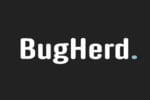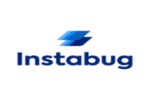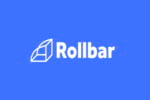As a user of the internet, it is without question that you’ve come across your fair share of bugs. You know the ones: those pesky little glitches that affect site load time, design, and general usability. If I’m candid, they’ve had me pulling my hair out on the odd occasion.
So, how can you limit the possibility of bugs impacting your websites, systems, and businesses?
Enter bug tracking software.
Bug tracking tools can help detect, identify, and fix bugs that may arise in software or website development, and after those software and platforms are live. This software can be used to assign tasks to the appropriate team member for fixing, assist in analyzing steps to squash the bug, and alert the right people that the problem is resolved.
In a nutshell, the right bug tracking software can simplify your life.
Now that you’re aware of some of the advantages of using bug tracking software in your business, we will talk about which bug tracking software may be a good option for your organization. This guide will also discuss things to keep in mind when deciding which is the right one for you.
The Top 5 Best Bug Tracking Software
- Zoho BugTracker – The Best for Scalability
- Jira – The Best for Software Development
- BugHerd – The Best for Web Developers
- InstaBug – The Best for Mobile Apps
- Rollbar – The Best Automated Bug Tracking Software
There is something in there for everyone. Stick with me as we go through each bug tracking software if a particular feature or capability sticks out to you.
Let’s dig in!
#1 – Zoho BugTracker — Best For Scalability
- Cloud-based tracker
- Fast and very scalable
- Automated defect alerts
- Starts free for 3 users
Zoho BugTracker is a cloud-based bug tracking software designed for businesses of all sizes. It’s simple, easy to use, fast, and extremely scalable. It sits among Zoho’s suite of incredible business applications, but it can also be used as a standalone product.
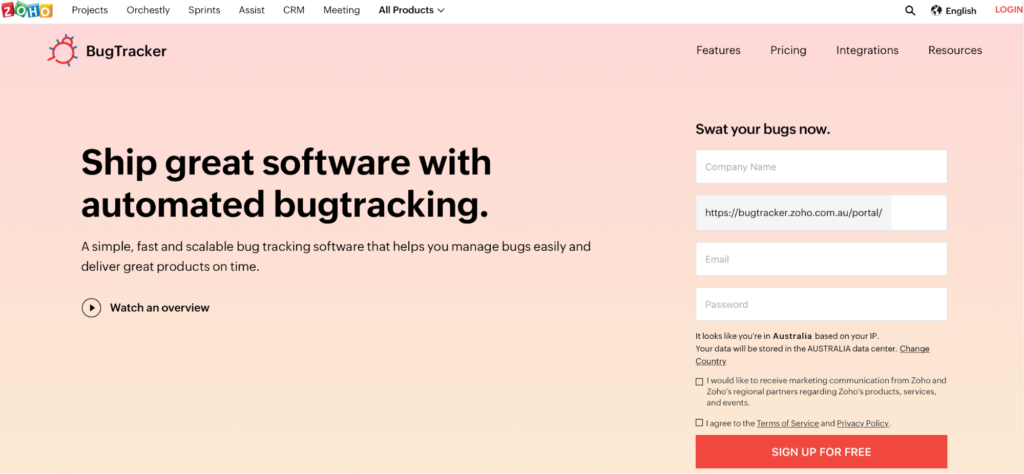
One of the main reasons Zoho BugTracker is so popular is its straightforward dashboard. Its usability means that just about anyone can work their way around the system. The software will record bugs quickly and report details, including severity and due date, assign them to users, and add followers all from the one dashboard.
Some other features of Zoho BugTracker are:
- Allows managers to trigger automated bug defect alerts via email to relevant parties
- Create custom fields and workflows
- Track your progress with bug reports in the form of charts or graphs
- Configure severity and set notifications for new bugs
- Filter bugs based on status, urgency, and user
- Create, upload, and store files in one place to collaborate easily with your team
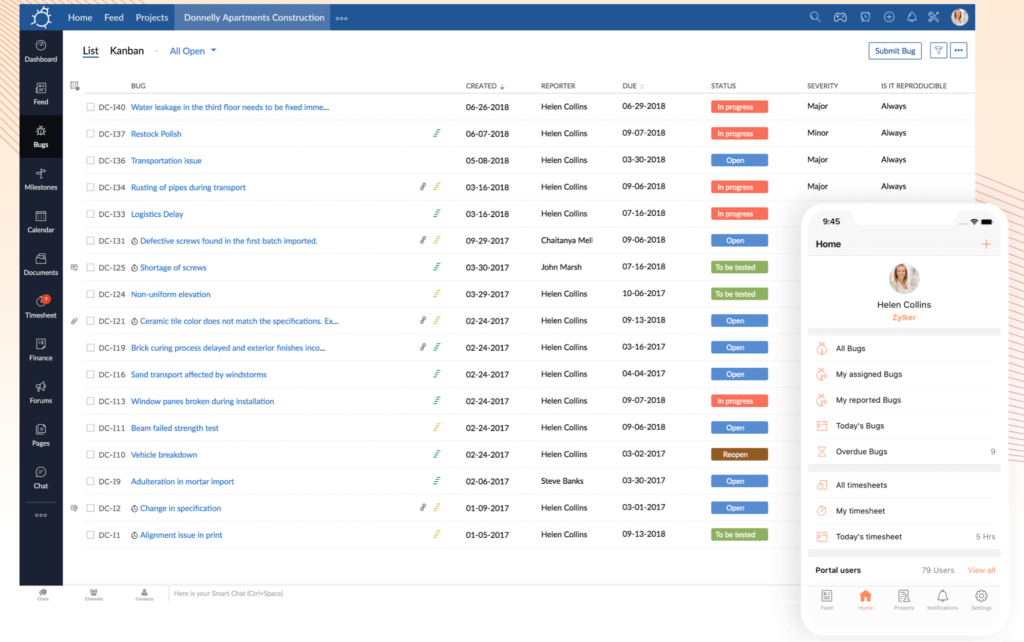
Zoho BugTracker is on our list as best for business scalability because of its month-to-month flexibility. You can start with a free monthly subscription to test the waters, and then you can upgrade, downgrade, or cancel at any time.
The monthly subscriptions with Zoho BugTracker look like this:
- Free: $0/month for 3 users
- Standard: $2 per user per month for up to 10 users
- Premium: $3 per user per month for up to 15 users (with unlimited scalability)
If you like the sound of Zoho BugTracker, you can start your 10-day free trial here.
#2 – Jira — Best for Software Development
- 3000+ integrations
- Optimized tracking workflow
- Agile reporting
- Comes with free plan
Jira is easily the pick of the list when it comes to the best bug tracking program for software development teams. It’s designed to catch bugs right in their tracks throughout the development process to ensure the end product is spot on.
With features like the ability to build custom project roadmaps to track progress from start to finish, it’s the perfect asset to assist agile teams in planning, tracking, and releasing software without skipping a beat. It also integrates with 3000+ third-party applications, so you’re unlikely to run into any software integration issues.
Something unique to this software is Jira’s own JQL (Jira Query Language), which allows developers to easily create queries and manipulate data within a short time.
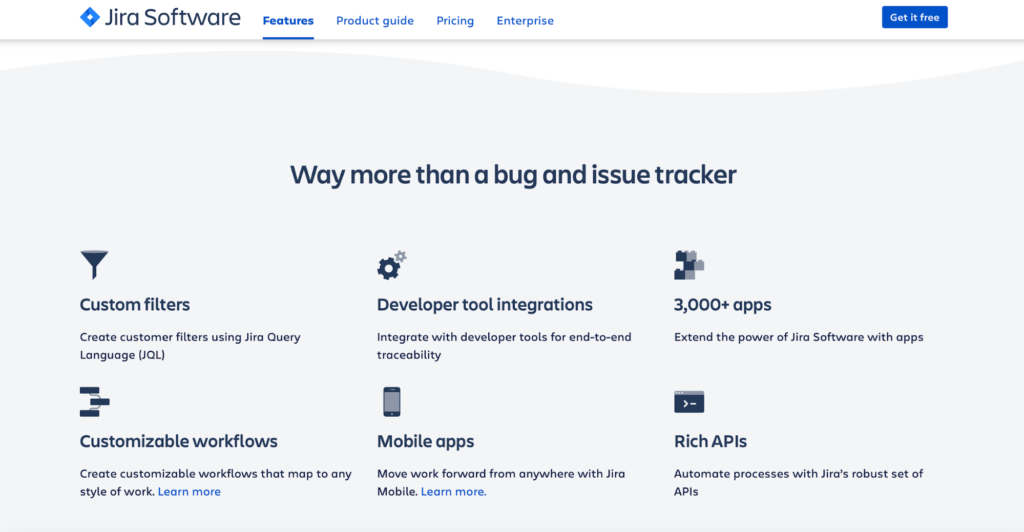
Other key features you can expect from Jira are:
- Capture bugs, assign and prioritize, and track to done, all within one workflow
- Automated notifications to the right parties when a new bug requires actioning
- Flexible workflow options such as Scrum and Kanban boards allowing full visibility for all your team members into what’s coming next
- Sketch out the big picture for key stakeholders with a visual roadmap
- Real-time, agile reporting with actionable insights
- Custom filters using JQL
As you can see, Jira is a great option for those looking for a program that can assist in both software development and project management. Of course, it can be used to track bugs alone, too.
For cloud-based access, Jira’s pricing plans are:
- Free: $0/month for up to 10 users
- Standard: $7 per user per month for minimum 10 users
- Premium: $14 per user per month for minimum 10 users
- Enterprise: Contact Jira for pricing. This plan is suitable for large organizations needing to manage more than one site.
You can either get started on your free plan today or take a 7-day free trial of the standard or premium plan.
#3 – BugHerd — Best for Web Developers
- Cloud-based bug tracking
- Automatically captures data
- Sticky notes feedback tool
- Starts at $39/month
BugHerd is a cloud-based bug tracking software positively loved by web developers and designers for website development. It is also a great feedback tool, allowing developers to work closely with clients on exactly which elements of the website need adjusting.
In a nutshell, it’s like using sticky notes to provide feedback, but on a webpage.
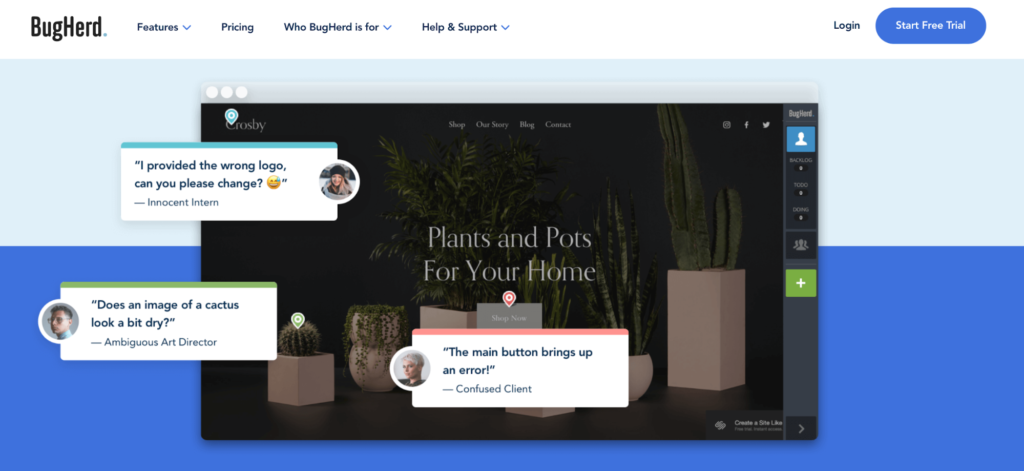
BugHerd’s simple bug tracking tool sits at the top of the client’s website and instantly lets the user log a bug. Any feedback or comments made on the bug are pinned to that element for easy resolution. It then categorizes the bugs into four categories: Backlog, To Do, Doing, and Done.
With such a simple process, the whole team (including the client) can stay up to date on what needs attention and each bug’s urgency.
Some other features you’ll find with BugHerd include:
- Automatically captures data relating to bug activity to allow your team to replicate and fix the bug issues faster
- Reports bugs and captures screenshots across mobile websites (premium plan only)
- Client feedback sticks directly to the element – so if the element is moved, there is no confusion on the updates required
- Simple installation options via Javascript or browser extension
BugHerd is used by the likes of Amazon, Nissan, and Dyson, among 6,000 other companies, so you can rest easy knowing that you are going to be in great hands for your next web development project.
The pricing plans available for this software are:
- Standard: $39/month for up to 5 users and 10 GB storage
- Studio: $59/month for up to 10 users and 20 GB storage
- Premium: $109/month for up to 25 users and 50 GB storage
- Enterprise: Contact for pricing
You can also request pricing for the standard, studio, or premium plans for more users (in lots of 25) through the website. All plans offer a free trial, so give BugHerd a whirl today.
#4 – InstaBug — Best for Mobile Apps
- Hybrid tracking solution
- Great for mobile teams
- Platform for beta testing
- Starts at $124/month
In a day and age where we use our phones for just about everything except for making phone calls, I had to include a bug tracking software for mobile apps. And really, how often do we find ourselves pulling our hair out over a crashed mobile app?
InstaBug is a hybrid in-app feedback and bug tracking solution that allows mobile teams to develop and release apps with confidence. It provides a platform for beta testing, comprehensive bug and crash reporting, and user engagement reports.
Testers can leave in-app bug reports by simply shaking their device when the issue is occurring. Or, if more detailed information is required, they can attach annotated screenshots, voice notes, or screen recordings to better describe the problem—all done within the app, without interruptions.
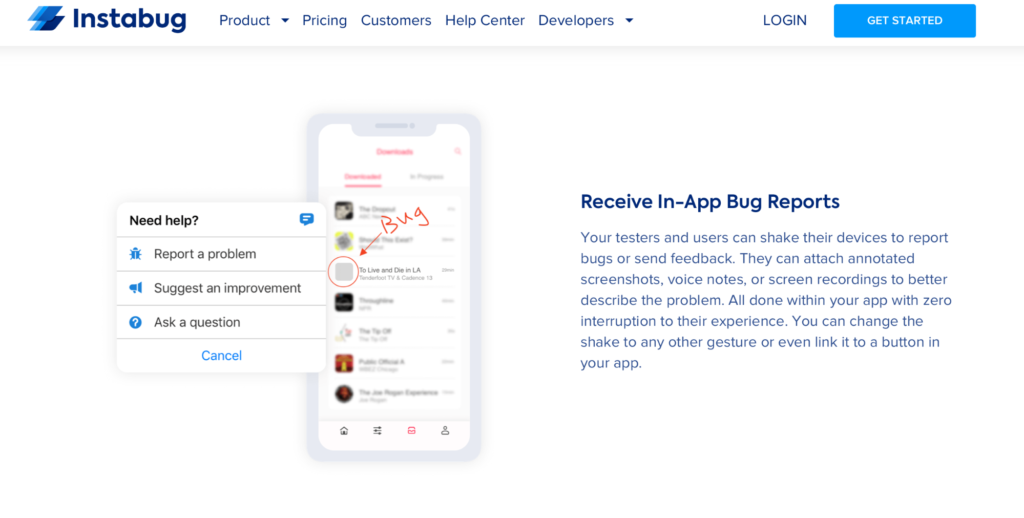
Some other key features of InstaBug include:
- Receive detailed logs and metadata related to each feedback submitted
- See the steps required to reproduce the issue along with a full overview of the user’s session details
- Send users in-app chats to ask for more information or let them know when their issue is fixed
- Integrations with project management workflows such as Trello, Jira, GitHub, and Slack
In terms of pricing, the basic plan only covers bug reporting and integrations. You can add extras to your plan, such as crash reporting, app performance monitoring, and user surveys for an additional fee. Otherwise, pricing plans for this software look like this:
- Basic: From $124/month for small companies
- Pro: From $208/month for medium and large companies
If you’re an indie developer, you can use this software in a very limited fashion for free. Or, if you’re an early-stage startup, you can speak to InstaBug to receive a discount on their plans.
See if InstaBug is worth the investment for your business with a 14-day free trial.
#5 – Rollbar — Best Automated Bug Tracking Software
- Automated bug tracking
- Intuitive dashboard
- Root cause analysis
- Starts free for 5,000 errors
Rollbar is a cloud-based bug tracking and monitoring solution that focuses on resolving issues while software is still in production. With Rollbar, software developers can spend more time building and less time fixing code.
Developers will save time with a little help from artificial intelligence. Rollbar uses AI to automatically monitor for errors, triage those errors, and then grade issues in order of severity.
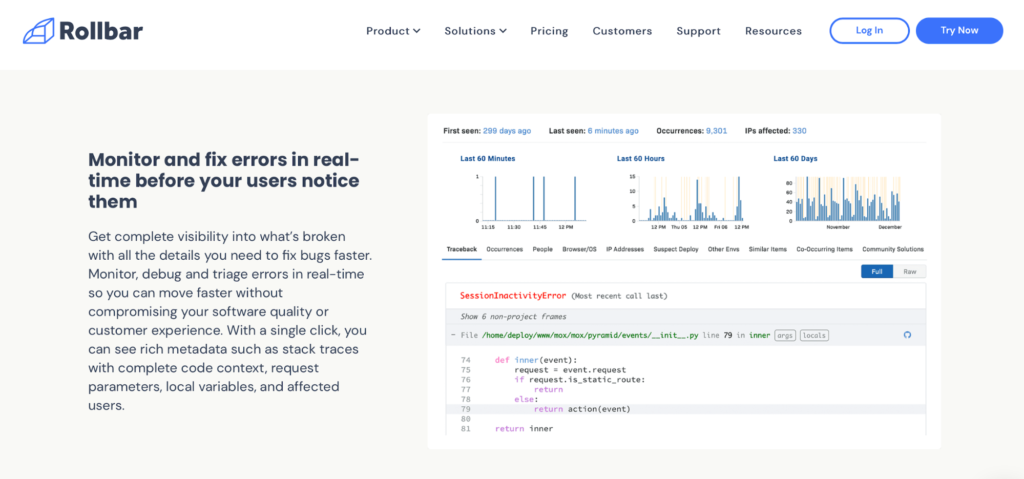
This software is designed to fix critical errors sooner with real-time alerts and automated workflows. It also reduces deployment risk with predictive code analytics at every step of your process, from development to staging to release.
Some other features you’ll have access to with Rollbar are:
- Straightforward dashboard with automation-grade grouping of errors
- Automatically receive all the diagnostic and contextual data needed to triage errors
- Root cause analysis
- Strong security with data encryption
- Custom integrations with full-featured REST API
Without a doubt, this software is a bug-catching powerhouse bound to make software developers’ lives so much easier.
Rollbar pricing plans are:
- Free: For up to 5,000 error events per month with essential features
- Essentials: From $1/month for up to 6,000 error events per month (includes additional features)
- Advanced: From $83/month for up to 100,000 error events per month (for multi-project teams)
- Enterprise: Custom event volume. Contact Rollbar for pricing.
To try Rollbar’s essential or advanced plan today, you can sign-up for their free trial here.
How to Find the Best Bug Tracking Software For You
We’ve only scratched the surface of the available bug tracking software on the market today. With so many options to choose from, it can be hard to determine which one might be best for your business.
In a nutshell, there are certain things that every bug tracking software should do at an absolute minimum. These include task management, customization to team preferences, collaboration among team members, and general information reporting.
If the bug tracking software you’re considering doesn’t include these things, step away from it and look for a better option.
When you’re doing your own research or testing out some free trials, consider the following criteria in your decision-making process.
Storage Capabilities
One complaint that came up a lot in my research and testing was the lack of storage space included in some of the lower-priced plans. Many tools have the option to upgrade the storage space, but it’s linked to a steep increase in price.
If you have a small team, you will likely find the storage included in the basic plans sufficient for your needs.
But if you’re a business facing lots of bug issues or have large projects, you may want to consider included storage a significant deciding factor when choosing the best bug tracking software for you.
Scalability
No matter the size of your organization, having the ability to adapt and scale as needed is always a good option to have. You never know how quickly business is going to take off.
Of course, we want just about any software to have the opportunity to scale alongside the growth of our business. However, aspects you should consider here are more in-depth than whether you can upgrade your plan to include more storage or more features.
Look at whether your bug tracking software can keep up in terms of the software’s speed when it’s under pressure to catch a lot of bugs or issues and how many tasks or users it can cope with at one time.
Does the software slow down or let bugs slip through the cracks when trying to identify and allocate lots of issues to team members in a short period of time, or can it keep up without breaking a sweat?
This consideration may help your decision between a cheaper software designed for smaller businesses or a pricier software developed to handle such workload.
Simplicity of Workflow
Usability is always an important consideration to make when introducing any new software into your business, but in the case of bug tracking software, it’s really important to make sure that the workflow is easy to understand and take action from.
At one point or another, you may have loads of bugs that need fixing all at the same time. Some will be of higher severity than others, and if your software workflow can’t tell you which is which or where it is, you are in for one big headache. And nobody wants that.
A good workflow should do three things:
- Capture and report
- Prioritize and assign
- Resolve and review
Following this, consider whether or not the workflow can be presented so that it is easy for everyone to understand clearly. Especially those who have no technical experience but want to be included in updates on the project (like managers or key stakeholders, for example).
Nearly every single bug tracking software offers a free trial, so there are plenty of opportunities to play around with different software to see which workflow you like best.
Summary
The two bug tracking software listed in this guide that will suit just about any business are Zoho BugTracker and Jira.
In this article, we’ve really taken a deep dive into five of the best bug tracking software option, each serving a different purpose. In reality, there are tons of options for you to choose from. To find the one that’s right for you, don’t forget to follow our recommended considerations and do the free trials to hone in on which software will be best for you and your business’s needs.
from Quick Sprout https://ift.tt/2LysIt9
via IFTTT


